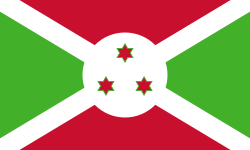
| Part of a series on the |
| Culture of Burundi |
|---|
 |
| People |
| Languages |
| Cuisine |
| Religion |
| Art |
| Music |
| Sport |


Burundi is situated in East Africa and has a territory full of mountains, savannas and agricultural fields, with forests in the surrounding rivers and waters. Agriculture is spread on 80% of the country's surface and it mainly includes coffee, tea, maize, beans and manioc. Burundi cuisine also includes beans, which are the staple of Burundi cooking, exotic fruits (mainly bananas), plantains, sweet potatoes, cassava, peas, maize, and cereals, like corn and wheat. [1]
Contents
The Burundian people usually eat homemade food, from homemade vessels also used for drinking, carrying water and storing grain. Food security remains a major problem in Burundi.[ citation needed ]
